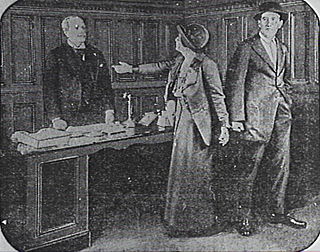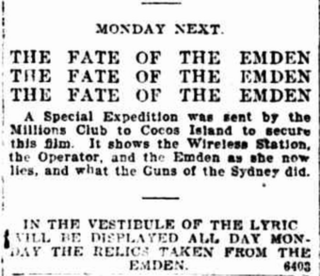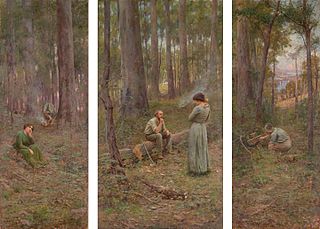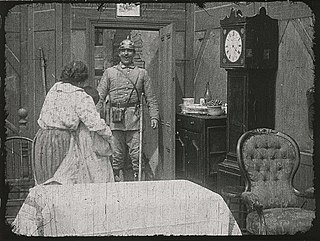Related Research Articles

Thunderbolt is a 1910 Australian feature film based on the life of the bushranger Captain Thunderbolt. It was the directorial debut of John Gavin who later claimed it was the first "four-reel movie" made in Australia. It has also been called the first film made in New South Wales.

William Joseph Lincoln was an Australian playwright, theatre manager, film director and screenwriter in the silent era. He produced, directed and/or wrote 23 films between 1911 and 1916.

The Hero of the Dardanelles is a 1915 Australian film directed by Alfred Rolfe, made as a patriotic war recruiting film.
The Silence of Dean Maitland is a 1914 Australian silent film directed by Raymond Longford. It is an adaptation of the 1886 novel of the same name by Maxwell Gray which was later filmed by Ken G. Hall in 1934. It is considered a lost film.

Alfred Rolfe, real name Alfred Roker, was an Australian stage and film director and actor, best known for being the son-in-law of the celebrated actor-manager Alfred Dampier, with whom he appeared frequently on stage, and for his prolific output as a director during Australia's silent era, including Captain Midnight, the Bush King (1911), Captain Starlight, or Gentleman of the Road (1911) and The Hero of the Dardanelles (1915). Only one of his films as director survives today.

Within the Law is a 1916 Australian silent film based a play of the same name by Bayard Veiller. The leading role was played by American stage star Muriel Starr, reprising her stage performance. It is considered a lost film.
Within Our Gates, also known as Deeds that Won Gallipoli, is a 1915 Australian silent film about Australia's fight with the German Empire and the Ottoman Empire during World War I, including the landing at Gaba Tepe during the Gallipoli campaign. The story was partly based on a play The Man Who Stayed at Home.
Robbery Under Arms is a 1907 Australian silent western/drama film based on the 1888 novel by Rolf Boldrewood about two brothers and their relationship with the bushranger Captain Starlight. It was the first film version of the novel and the third Australian feature ever made.
The Sunny South, or the Whirlwind of Fate is a 1915 Australian silent film directed by Alfred Rolfe based on the popular play The Sunny South by George Darrell. It is considered a lost film.

The Loyal Rebel is a 1915 Australian silent film directed by Alfred Rolfe set against the background of the Eureka Rebellion.

How We Fought the Emden is a 1915 Australian silent documentary film from cinematographer Charles Cusden about the Battle of Cocos during World War I, where the Australian ship Sydney sunk the Emden.
Charles Villiers was an Australian actor and occasional director who appeared in many silent films. According to a contemporary report, "there is probably no actor in Australia that has done more consistent picture work than Mr. Villiers, both as heavy lead, and director." He was particularly well known for playing villains.

The Pioneers is a 1916 Australian silent film directed by Franklyn Barrett. It is considered a lost film.

The Joan of Arc of Loos is a 1916 Australian silent film shot by Franklyn Barrett based on the true story of Émilienne Moreau-Evrard in World War I. Only a portion of the movie survives today.
Seven Keys to Baldpate is a 1916 Australian silent film directed by Monte Luke for J. C. Williamson's. It was the first film adaptation of the popular play by George M. Cohan which had toured Australia successfully in 1914 with Fred Niblo. There were later versions of the story in 1917, 1925, 1929, 1935 and 1947.
In the Last Stride is a 1916 Australian silent film directed by Martyn Keith based on the 1914 popular action novel by Arthur Wright. The film's star, Dave Smith, was a champion heavyweight boxer who had fought Les Darcy. There was also an appearance from boxer Les O'Donnell.

Charlie at the Sydney Show is a 1916 Australian short film starring Charlie Chaplin impersonator Ern Vockler dircted by John Gavin.
For the Honour of Australia is a 1916 film composed of footage from two 1915 Australian silent films, For Australia and How We Beat the Emden, plus the documentary How We Fought the Emden.

How We Beat the Emden is a 1915 Australian silent film directed by Alfred Rolfe about the Battle of Cocos during World War I. It features footage shot on Cocos Island.
A Man – That's All (1916) is an Australian war film directed by Alfred Rolfe for Australasian Films.
References
- ↑ "Classified Advertising". The Argus . Melbourne. 9 December 1915. p. 14. Retrieved 13 June 2012– via National Library of Australia.
- ↑ "Production Of Moving Pictures--In America And Australia". Australian Town and Country Journal . Vol. XCVIII, no. 2555. New South Wales, Australia. 18 December 1918. p. 21. Retrieved 21 November 2023– via National Library of Australia.
- 1 2 Andrew Pike and Ross Cooper, Australian Film 1900–1977: A Guide to Feature Film Production, Melbourne: Oxford University Press, 1998, p 55
- ↑ "The Dandies". The Barrier Miner . Broken Hill, NSW. 2 May 1916. p. 3. Retrieved 13 June 2012– via National Library of Australia.
- ↑ ""Sydney-Emden Fight" At The Royal". The Barrier Miner . Broken Hill, NSW. 4 May 1916. p. 3. Retrieved 13 June 2012– via National Library of Australia.
- 1 2 Marsden, Ralph. 'The Old Tin Shed in Exhibition Street': The J. C. Williamson Studio, Melbourne's Forgotten Film Factory [online]. Metro Magazine: Media & Education Magazine, No. 157, 2008: 144-153. Availability: <http://search.informit.com.au/documentSummary;dn=519108300276483;res=IELAPA> ISSN 0312-2654. [cited 15 Nov 14].
- ↑ "Movie "Heavy" Chats Lightly". The Winner. Melbourne. 22 December 1915. p. 12. Retrieved 15 November 2014– via National Library of Australia.
- ↑ "The Picture Shows". The Winner. Melbourne. 20 October 1915. p. 10. Retrieved 15 November 2014– via National Library of Australia.
- ↑ Paul Byrnes, For the Honour of Australia at Australian Screen Online